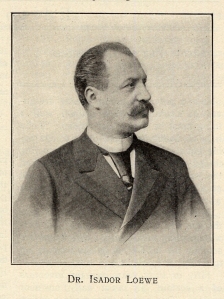 Some time ago, Jon Speed and I were discussing Ludwig Loewe AG and the man that led the company to its greatest achievements; while Ludwig Loewe, his older brother founded the company and established its essential character, which is as a firm that took advances and concepts of American machine design and techniques and adapted them to the German market, it was Isidor Loewe that led the company to the massive international conglomerate it became, largely with help of his brother (Ludwig was a politician, Germany industrialization was unique, different than England’s or America’s in that it relied heavily upon government contracts and support-intrusion, it is probably the main reason why Germany went from a backward country to an equal of England and a serious competitor to America in a little over 70 years) and banking interests.
Some time ago, Jon Speed and I were discussing Ludwig Loewe AG and the man that led the company to its greatest achievements; while Ludwig Loewe, his older brother founded the company and established its essential character, which is as a firm that took advances and concepts of American machine design and techniques and adapted them to the German market, it was Isidor Loewe that led the company to the massive international conglomerate it became, largely with help of his brother (Ludwig was a politician, Germany industrialization was unique, different than England’s or America’s in that it relied heavily upon government contracts and support-intrusion, it is probably the main reason why Germany went from a backward country to an equal of England and a serious competitor to America in a little over 70 years) and banking interests.

In the companies early years, all the early machines they made, the sewing machines through machine tools, were essentially American designs adapted to German conditions, where as American methods focused upon mass production of simple but robust designs, often designed to make one thing in enormous number and of the greatest simplicity and durability, the European model was not as dependent upon sheer numbers, rather versatility was more important, small shops with lower capacity for a smaller market. One of the motto’s the firm professed in 1899 was “Das Beste ist das Billigste” which Wolfgang defined as meaning, in the German context as “The best is the cheapest (low cost/cost efficient/value for money)”, he explained the concept as “Highly skilled workers (with higher salary), working with high quality machinery/tools (expensive) are cheaper (monetary) in the long term, than less qualified workers (with less salary), working with no or poor machines/tools. Because they manufacture products of higher standards/quality. No rejections/junk”, which in many ways mirrors the American theory of production in the 19th century, though by the turn of the last century that was changing due to labor concerns (American skilled workers were the highest paid in the world, far more than in England or Germany), which was forcing a reconsideration of methods, eventually the concept of simple, more automated machines which less skilled men, fewer and lower paid, could operate took hold.